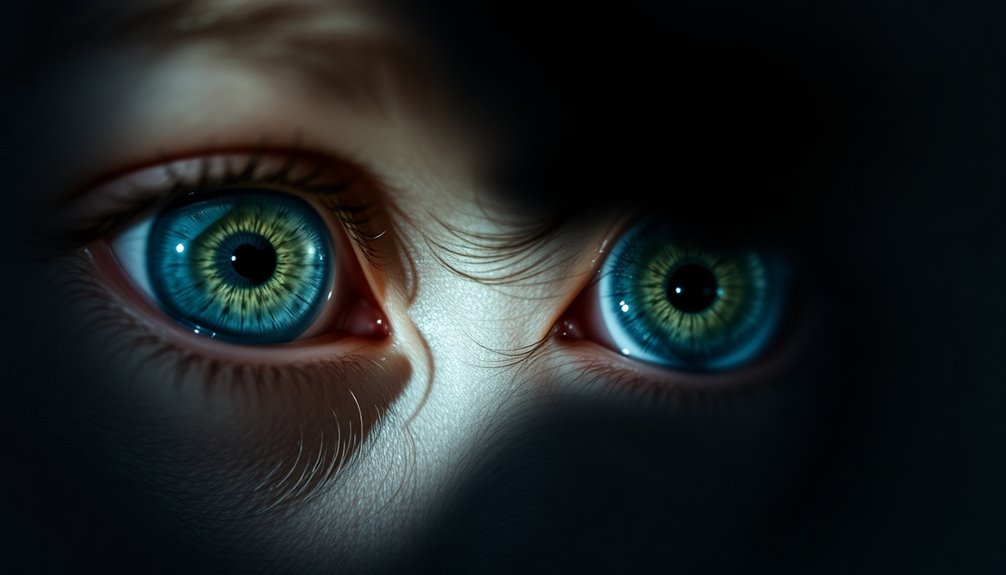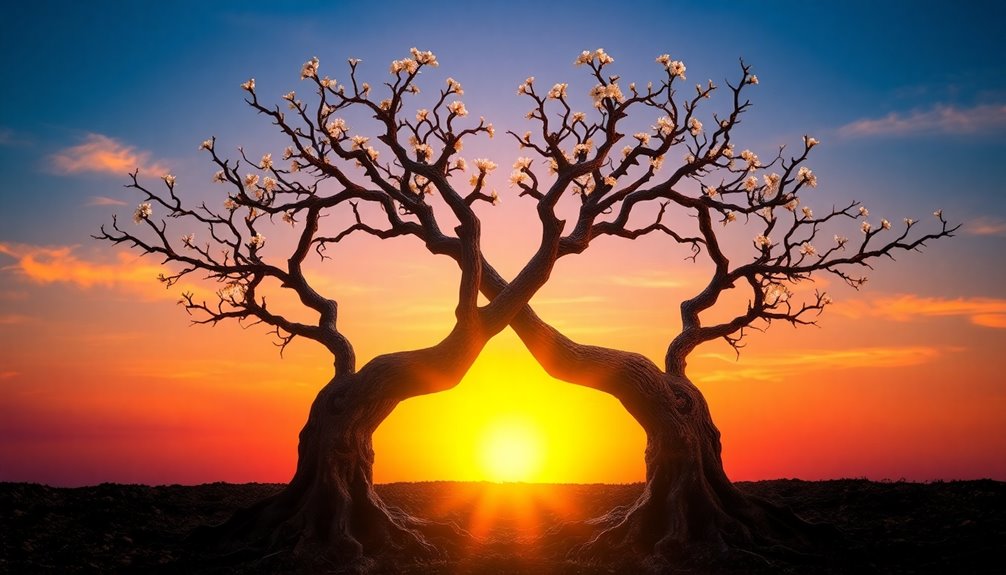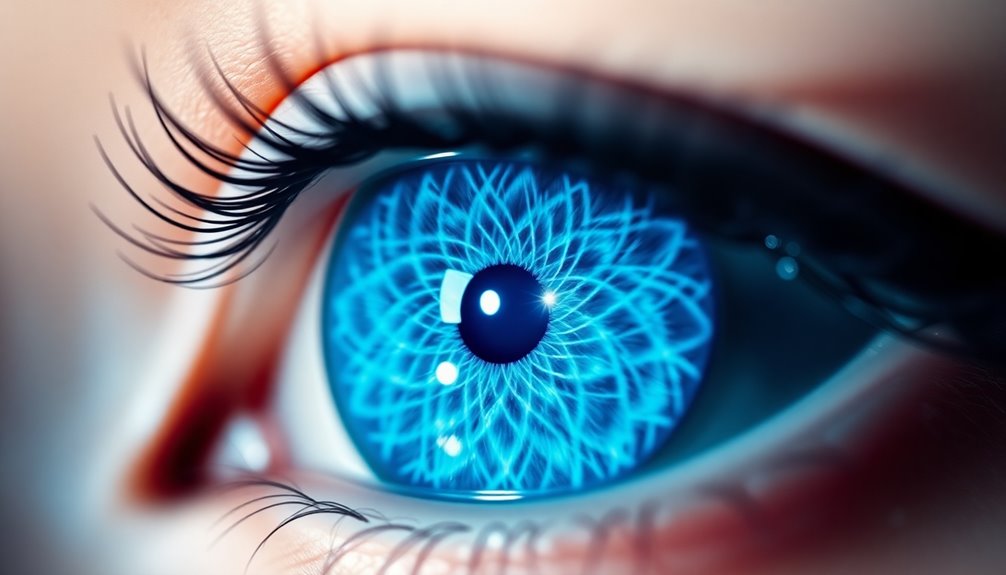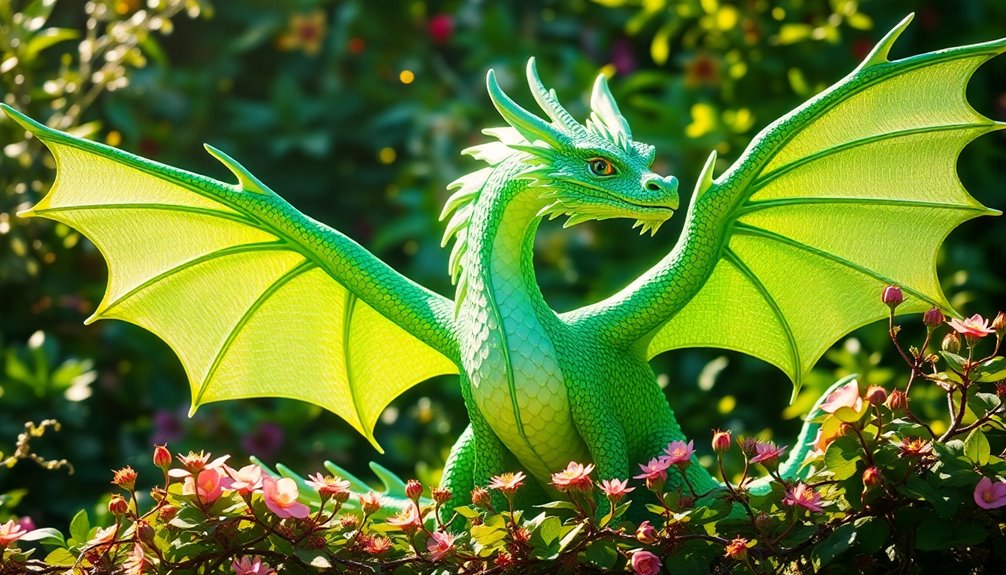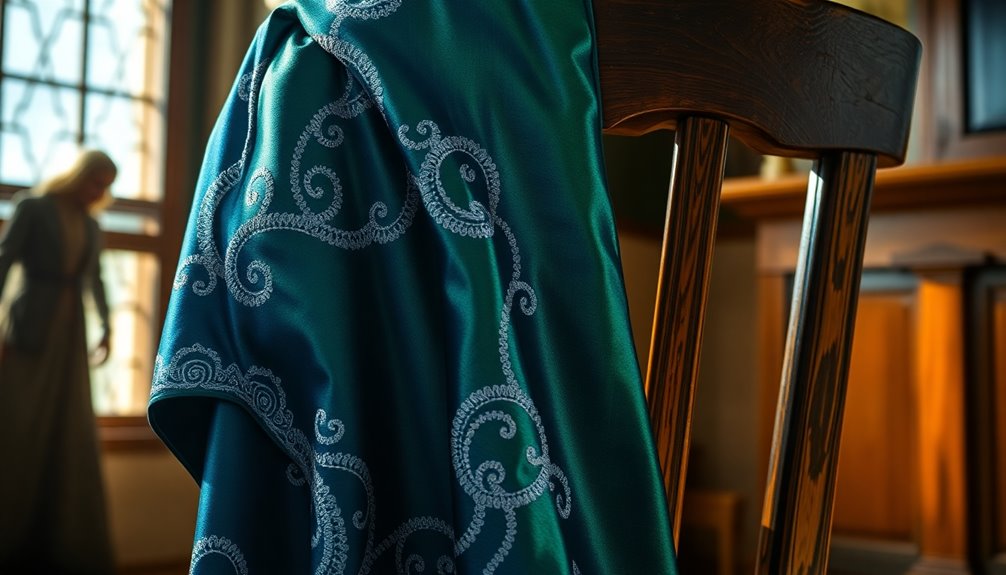Gray eyes hold a unique spiritual significance, often linked to clairvoyance and profound wisdom. Because they're rare—found in less than 1% of the global population—they carry an air of mystique and depth. You might find that people with gray eyes are seen as enigmatic, possessing heightened intuition and emotional stability. Cultures throughout history have celebrated these ashen gazes, viewing them as symbols of insight and intellectual depth. If you're curious about how these traits manifest in personalities or the lore surrounding gray eyes, you'll discover even more intriguing connections to explore further.
Key Takeaways
- Gray eyes symbolize heightened spiritual awareness and clairvoyance, often linked to wisdom and prophetic insight in various cultures.
- Their rarity, found in less than 1% of the population, enhances their mystical aura and significance.
- Ancient Greeks viewed gray eyes as symbols of profound understanding, connecting them to deeper emotional and intellectual depth.
- Folklore frequently associates gray eyes with supernatural beings, emphasizing their spiritual connections and romanticized narratives.
- Individuals with gray eyes are often perceived as enigmatic, embodying resilience, loyalty, and captivating perspectives in social interactions.
Spiritual Significance of Gray Eyes

Gray eyes hold a unique spiritual significance that sets them apart from other eye colors. They're often linked to clairvoyance, suggesting you might possess a heightened spiritual awareness and the ability to perceive unseen energies. This rare eye color, found in less than 1% of the global population, symbolizes a unique connection to the metaphysical domain, making you stand out in a world full of color.
Historically, gray eyes have been associated with wisdom and prophetic insight. You may find that this deep intellectual and contemplative nature enables you to navigate life's challenges with grace. Your inner strength is palpable, allowing you to face difficulties with resilience and depth.
The neutral tones of gray often represent balance, hinting at a journey toward emotional equilibrium and spiritual growth. Embracing the spiritual significance of gray eyes means recognizing your potential for profound understanding. Additionally, those with gray eyes may excel in multicultural environments due to their cultural intelligence (CQ), enhancing their ability to relate to others on a deeper level.
You might discover that this unique eye color not only reflects your inner world but also guides you toward greater self-awareness and connection with the universe. Essentially, your gray eyes are more than just a physical trait; they symbolize a deeper journey into the spiritual domain.
Rarity and Genetics of Gray Eyes
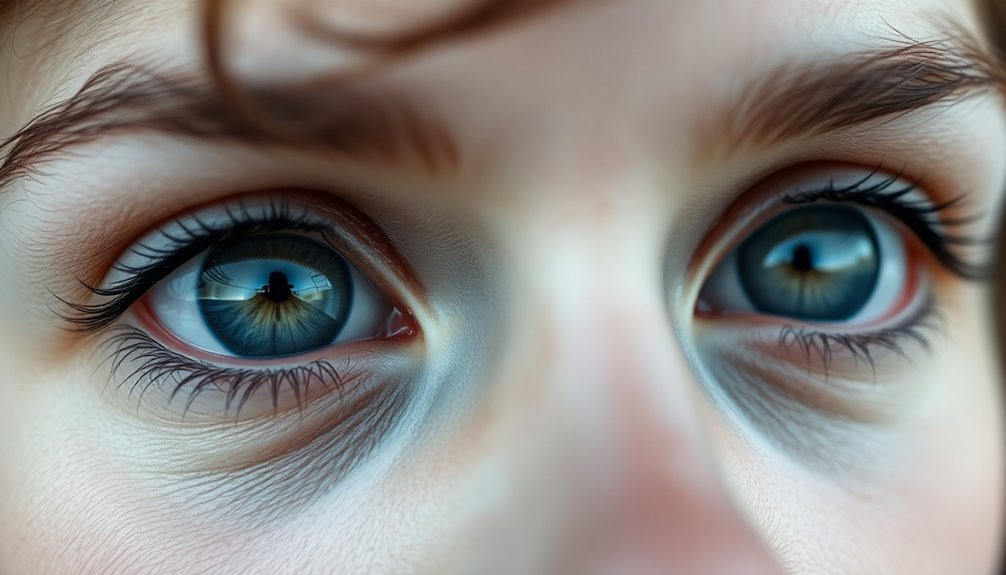
The unique spiritual significance of gray eyes is mirrored by their rarity in the population. Less than 1% of people worldwide possess this enchanting eye color, making it a remarkable genetic trait. The rarity stems from a complex interplay of genetics, particularly involving melanin production and expression. Key genes such as OCA2, HERC2, SLC24A4, and TYR are essential in determining eye pigmentation.
Here's a quick overview of the genetics behind gray eyes:
| Aspect | Details |
|---|---|
| Rarity | Less than 1% of the global population |
| Common Ancestry | Eastern and Northern European |
| Key Genes | OCA2, HERC2, SLC24A4, TYR |
| Inheritance Pattern | Incomplete dominance |
Gray eyes are most frequently found in individuals with European ancestry, especially in countries like Estonia and Finland. The inheritance of gray eyes showcases incomplete dominance, leading to diverse expressions of eye color based on genetic combinations. This genetic uniqueness contributes to the mystical aura often associated with gray eyes, enhancing their spiritual significance.
Personality Traits Associated With Gray Eyes
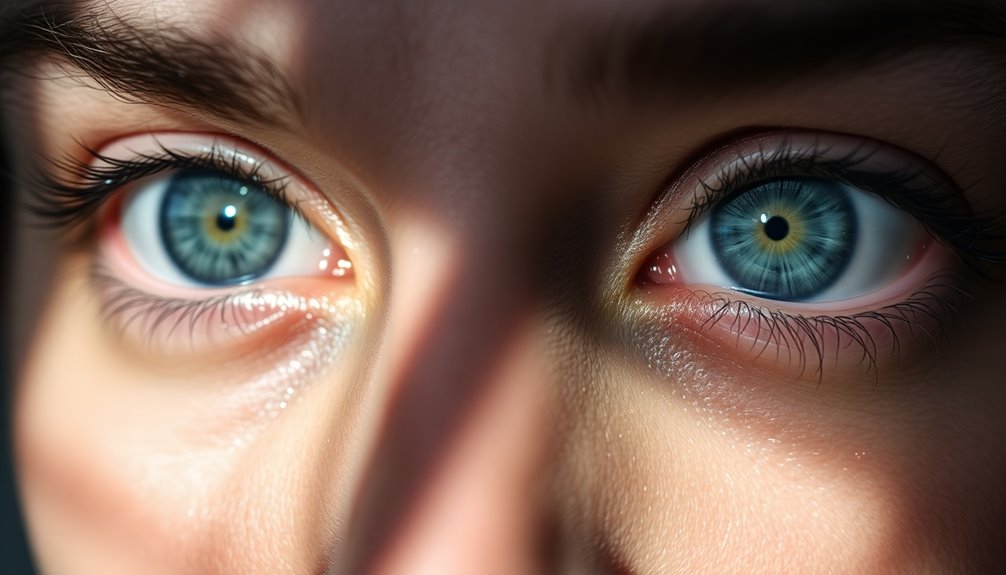
Often seen as enigmatic, individuals with gray eyes tend to embody a blend of intellect and emotional resilience. With less than 1% of the global population sharing this unique eye color, you might find that gray-eyed people often possess enchanting personality traits that intrigue those around them.
Their heightened intellectual depth allows for analytical thinking and strategic decision-making, making them reliable problem solvers. Gray eyes are often associated with wisdom and prophetic insight, suggesting that you may be viewed as more knowledgeable and perceptive by others. This perception can enhance your social interactions, as people seek your guidance and opinions.
Additionally, your emotional stability enables you to navigate life's challenges with grace, reflecting a strong and resilient spirit. Many gray-eyed individuals also exhibit traits of loyalty and faithfulness, particularly among men, which can strengthen their appeal as trustworthy companions.
Essentially, if you have gray eyes, you likely embody a rich tapestry of personality traits that combine insight, strength, and a unique allure that draws others in. Your presence can inspire admiration and respect, making you a fascinating individual in any social setting.
Notable Celebrities With Gray Eyes

When you think of gray-eyed celebrities, names like Angelina Jolie and Meryl Streep likely come to mind.
Their striking eye color not only enhances their looks but also influences cultural trends, showcasing the allure of gray eyes in the industry.
Let's explore how these famous stars and their unique eye color impact our perception of beauty and charisma.
Famous Gray-Eyed Stars
Gray eyes have a unique allure that enchants both audiences and fans alike, and many notable celebrities possess this striking feature.
Take Angelina Jolie, for instance. Her enchanting gray eyes not only enhance her striking looks but also reflect a nurturing spirit, evident in her humanitarian efforts.
Meryl Streep, celebrated as one of the greatest actresses, has gray eyes that convey a deep connection to the diverse roles she embodies, showcasing her unique ability to resonate with audiences.
Other stars like Jai Courtney and Pink bring their own flair to the industry, with their natural gray eye color contributing to their distinct styles.
Clint Eastwood's legendary status is intensified by his commanding presence, bolstered by his mesmerizing gray eyes.
Meanwhile, Shia LaBeouf's diverse roles are enriched by the intrigue his gray eyes add to his characters.
Finally, Maisie Williams, known for her role in "Game of Thrones," captures attention with her striking gray eyes that complement her unique persona.
These celebrities not only embody the allure of gray eyes but also illustrate how such features can enhance their spiritual journey in the public eye.
Cultural Impact of Gray Eyes
The allure of gray eyes extends beyond individual celebrities to shape cultural narratives and perceptions. Notable figures like Angelina Jolie, Meryl Streep, and Clint Eastwood not only showcase the rare beauty of grey eyes but also embody the wisdom and mystery often associated with this striking color. With less than 1% of the population possessing gray eyes, they've become a symbol of depth and intrigue in popular culture.
| Celebrity | Associated Traits | Cultural Impact |
|---|---|---|
| Angelina Jolie | Allure, Complexity | Powerful Femme Fatales |
| Meryl Streep | Wisdom, Versatility | Icon of Artistic Excellence |
| Clint Eastwood | Ruggedness, Authority | Archetype of the Stoic Hero |
Characters with gray eyes, like Draco Malfoy and Luna Lovegood, also reflect these qualities, often linked to the supernatural and intellect. Historically, cultures regarded gray eyes as mystical, connecting them to wisdom and insight. This cultural fascination enhances the appeal of gray eyes, making them a profound feature in literature and art, embodying unique and powerful traits.
Iconic Characters Featuring Gray Eyes
Portraying a range of emotions and traits, iconic characters with gray eyes often leave a lasting impression on audiences. These characters embody qualities that invite intrigue and exploration, making them memorable in their respective narratives.
Their gray eyes symbolize wisdom, depth, and a touch of the mystical, which enhances their enigmatic personas.
Consider some of these notable characters:
- Draco Malfoy from Harry Potter, whose gray eyes reveal layers of complexity and depth.
- Luna Lovegood, also from Harry Potter, showcases gray eyes that reflect her ethereal and mystical nature.
- Tooru Yukimura in anime, whose calm gray eyes convey strategic thinking.
- Tsukihi Araragi from the Monogatari series, presenting gray eyes that symbolize emotional distance and depth.
These characters illustrate how gray eyes can signify a wealth of traits, from wisdom to mystery. They captivate audiences with their unique perspectives and complex personalities.
When you encounter gray-eyed characters, you're often drawn to their stories, sensing that there's more beneath the surface waiting to be uncovered.
Shopping for Gray Eye Contacts
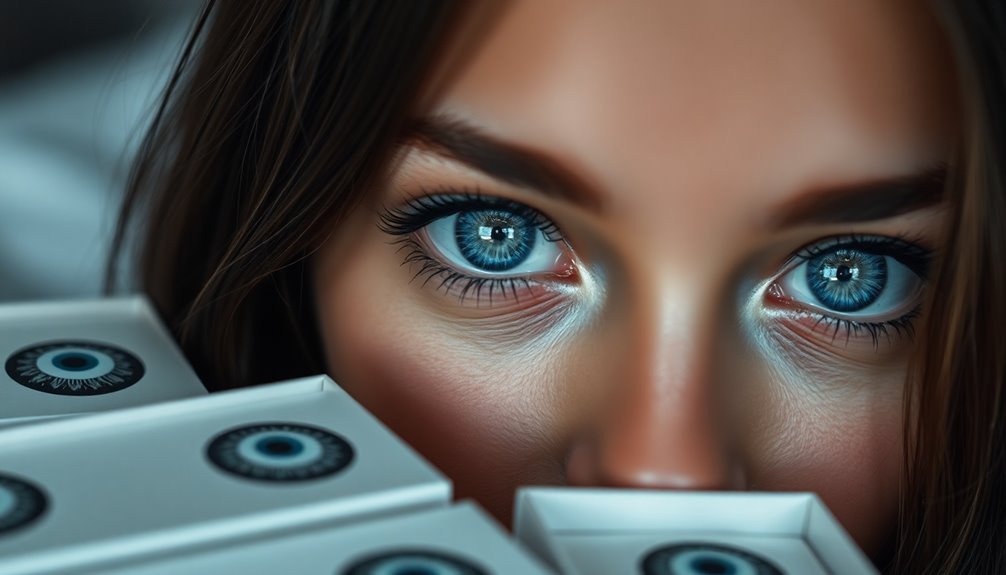
If you're looking to transform your look, shopping for gray eye contacts can be an exciting venture. With Mesmereyez's diverse collection of natural gray contact lenses, you can enhance your eye color for any occasion.
Whether you want a temporary change for a day or a more lasting effect for up to a year, there's an option that fits your lifestyle. These lenses are designed to offer the unique allure of gray eyes, giving you a striking yet natural appearance.
Plus, you'll enjoy the convenience of free shipping across Australia, making it easier than ever to get your desired look without breaking the bank.
When you're unsure about which lenses to choose, Mesmereyez provides personalized assistance through their customer service. Don't hesitate to reach out for advice on finding the perfect pair that suits your style and needs.
Once you've selected your lenses, consider sharing your new look on social media. Tag Mesmereyez on Instagram to connect with a community of fellow enthusiasts and showcase how you've embraced this stunning change.
Shopping for gray eye contacts has never been more rewarding!
Cultural Interpretations of Gray Eyes
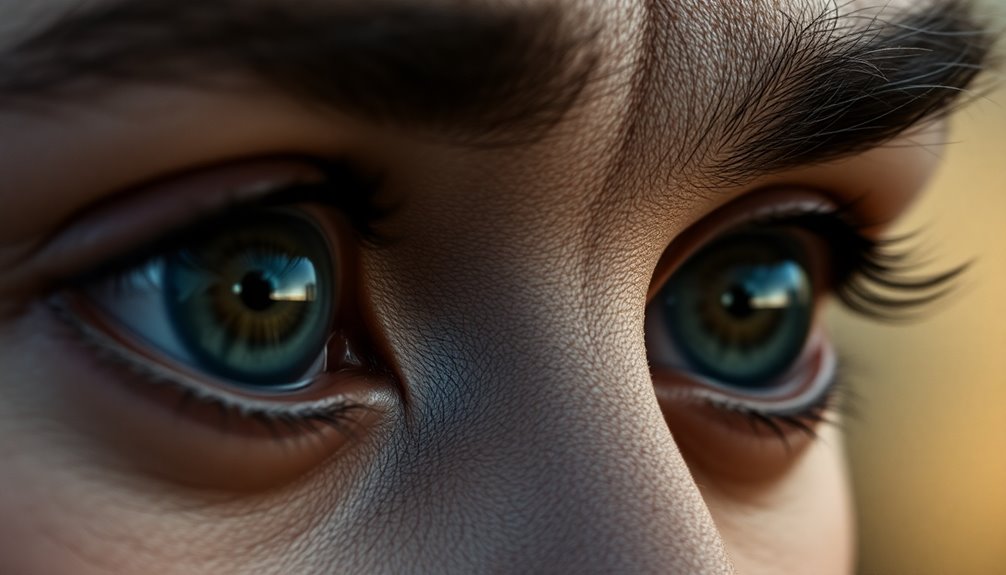
When you consider gray eyes, you'll notice they hold a special place in various cultures, often seen as symbols of wisdom and insight.
Their mysterious allure has captivated many, making them a romanticized feature in literature and folklore.
People often view gray-eyed individuals as unique, appreciating their deep emotional capacity and connection to the spiritual dimension.
Mystical Symbolism in Cultures
Gray eyes hold a unique place in various cultures, often symbolizing mystery and a deeper connection to the spiritual sphere. People with grey eyes are frequently seen as having an otherworldly presence, believed to bridge the gap between the earthly and the ethereal.
Here are some key interpretations surrounding grey eyes:
- Wisdom: Ancient Greeks viewed grey eyes as a sign of insight, suggesting that those who possess them are knowledgeable figures in society.
- Clairvoyance: Many cultures associate grey eyes with prophetic abilities, implying a heightened awareness of hidden truths and future possibilities.
- Mystery: The rarity of grey eyes—seen in less than 1% of the global population—adds to their allure and mystique, often leading to romanticized narratives.
- Supernatural Beings: Folklore often ties grey eyes to supernatural beings like angels or wizards, enhancing their connection to the spiritual sphere.
In essence, grey eyes are more than just a physical trait; they embody a rich tapestry of cultural symbolism, suggesting a deeper connection to wisdom and the mysteries of life.
Perceptions of Wisdom and Insight
The perception of wisdom and insight often intertwines with the distinctive trait of grey eyes across various cultures. In ancient Greece, grey eyes symbolized profound understanding, suggesting you possess a deeper connection to life's mysteries. Many cultures view grey eyes as a mark of clairvoyance, linking them to heightened spiritual awareness and the ability to see beyond the ordinary.
When you encounter someone with grey eyes, you might notice the emphasis on strategic thinking and analytical prowess. These traits are celebrated in various narratives, where characters with grey eyes often emerge as wise mentors or powerful figures. This connection reinforces the idea that grey eyes signify not just uniqueness but also a reservoir of insight.
Moreover, since grey eyes are found in less than 1% of the global population, their rarity enhances their mystique, further solidifying the belief that those who possess them are endowed with profound wisdom.
You might find that individuals with this unique eye color often inspire others, making them symbols of spiritual depth and understanding. Essentially, grey eyes invite you to explore the deeper domains of wisdom and insight.
Romanticized Beauty and Allure
Mystique surrounds gray eyes, often elevating them as symbols of beauty and allure in various cultures. You'll find that gray eyes, often seen as enigmatic, carry a weight of romanticized beauty, enchanting those who gaze into them. Their unique shade doesn't just stand out; it suggests a deep connection to the mysteries of the universe and the wisdom held within.
Consider how gray eyes are perceived in different contexts:
- Characters with gray eyes in literature often embody intelligence and emotional depth.
- Historical narratives associate gray eyes with prophetic abilities and clairvoyance.
- In some cultures, they're celebrated as a mark of beauty and distinction.
- The rarity of gray eyes, found in less than 1% of the population, adds to their allure.
These interpretations enhance the charm of individuals with gray eyes, making them objects of fascination and admiration. The increase in female participation in various fields, including esports and creative arts, can also be seen as a reflection of the diverse beauty gray eyes represent.
With each glance, you might sense the layers of meaning embedded within those ashen hues, reflecting not just beauty but also a profound understanding of the world around you. Gray eyes invite you to explore the depths of their significance and the stories they tell.
Enhancing Your Look With Gray Eyes
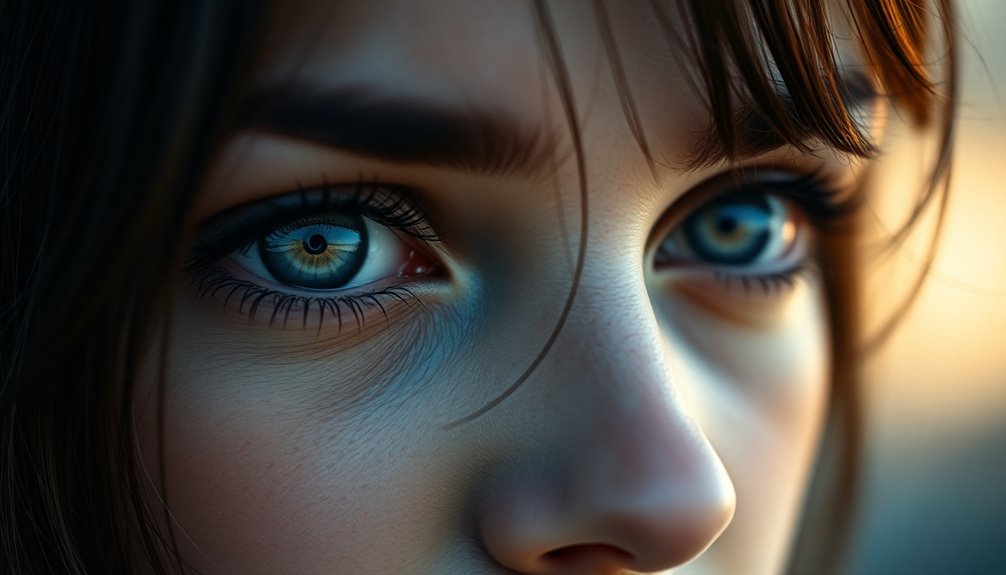
Enthralling gray eyes can truly make a statement, and there are plenty of ways to enhance their striking appearance. One effective strategy is incorporating colors like blues, purples, and jewel tones into your wardrobe. These shades complement the unique hues found in your gray irises, making your eyes pop.
If you want a quick change, consider gray contact lenses. They come in various shades, allowing you to experiment with different looks without any permanent commitment.
Makeup strategies can also elevate your gray eyes. Opt for darker eyeliner to define your gaze and choose cool-toned eyeshadows that reflect the subtle beauty of your irises. This not only highlights their vibrancy but also deepens your spiritual connection to your unique features.
Don't overlook the power of accessories! Wearing scarves or clothing in contrasting colors can draw attention to your eyes, creating a cohesive and stylish appearance.
If you're unsure where to start, a professional consultation can provide guidance on the best cosmetic options, ensuring you achieve your desired look safely and comfortably.
Embrace your gray eyes and let them shine!
Frequently Asked Questions
What Do Grey Eyes Mean Spiritually?
When you consider grey eyes spiritually, you might notice their association with intuition and hidden truths.
People often see those with grey eyes as wise and insightful, suggesting a depth of understanding beyond the ordinary.
Their rarity adds a unique charm, making you feel special if you have them.
You may also find that grey eyes reflect your resilience and strength, helping you navigate life's challenges with grace and a rich inner world.
What Are the Powers of Grey Eyes?
Imagine gazing into the depths of a stormy sea; that's what grey eyes can evoke.
You might find that those with grey eyes possess unique powers, like heightened intuition and analytical skills, allowing you to perceive subtleties others miss.
This rare eye color often suggests resilience and a profound understanding of life's complexities.
Embracing these traits can empower you to navigate challenges with wisdom and insight, making you a true force in your own right.
What Is the Grey Eyes Theory?
The Grey Eyes Theory suggests that if you have grey eyes, you might possess heightened clairvoyant abilities. It implies that you can perceive energies and events beyond the ordinary domain.
This theory stems from the unique genetic traits associated with grey eyes, which are quite rare. Historically, cultures viewed grey-eyed individuals as wise and insightful, often linking them to strategic thinking and emotional resilience.
Your grey eyes could symbolize a deeper connection to intuition and insight.
What Does It Mean When Someone's Eye Is Grey?
When you look into someone's grey eyes, it's like peering into a calm, mysterious sea—deep and full of potential.
Grey eyes often signify wisdom and resilience, suggesting that the person possesses a unique perspective on life. Their rarity adds to their allure, hinting at individuality.
You may notice they respond sensitively to their surroundings, reflecting an emotional depth that makes them particularly insightful and understanding of the world around them.
Conclusion
In the end, gray eyes are more than just a striking feature; they're a window into a world of depth and mystery. Embracing the spiritual significance and unique personality traits associated with gray eyes can inspire you to celebrate your individuality. After all, isn't it fascinating how something as simple as an eye color can carry such profound meaning? So whether you've got gray eyes or just admire them, remember: beauty truly lies in the eyes that see the soul.

